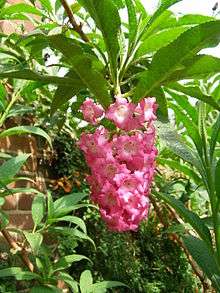Buddleja colvilei
Buddleja colvilei is endemic to the eastern Himalaya; discovered by Hooker in 1849, he declared it 'the handsomest of all Himalayan shrubs.' [1] In 1896 the species was awarded the RHS First Class Certificate (FCC),[2] given to plants 'of outstanding excellence for exhibition'.[3]
| Buddleja colvilei | |
|---|---|
 | |
| Scientific classification | |
| Kingdom: | Plantae |
| Clade: | Tracheophytes |
| Clade: | Angiosperms |
| Clade: | Eudicots |
| Clade: | Asterids |
| Order: | Lamiales |
| Family: | Scrophulariaceae |
| Genus: | Buddleja |
| Species: | B. colvilei |
| Binomial name | |
| Buddleja colvilei | |
Description
B. colvilei is a deciduous large shrub or small tree which can grow > 13 m, often single stemmed. The flowers are arranged in drooping panicles, 15–20 cm long by > 8 cm wide, rose pink to crimson, but often white within the corolla tube. The flowers are among the largest of any in the genus, and appear in June. The leaves are < 25 cm long, narrow, shallowly - toothed, and tapered at either end.[1] This species has a high degree of polyploidy with a correspondingly high chromosome number of 2n = 152–456 (8x–24x).[4]
Cultivation
The shrub is not entirely hardy in the UK, and can only be reliably grown outdoors along the Atlantic coast.[1] Hardiness: United States Department of Agriculture zones 8–9.[5]
Cultivars
- Buddleja colvilei 'Kewensis', distinguished by its dark red flowers.
References
- Bean, W. J. (1914). Trees and shrubs hardy in the British Isles. 7th Ed. 1950, Vol. 1, p. 320.
- Hillier & Sons. (1990). Hillier's Manual of Trees & Shrubs, 5th ed.. p. 47. David & Charles, Newton Abbot. ISBN 0-7153-67447
- Royal Horticultural Society, (2005). RHS Plant Finder 2005-2006, Dorling Kindersley. ISBN 1-4053-0736-6
- Chen, G, Sun, W-B, & Sun, H. (2007). Ploidy variation in Buddleja L. (Buddlejaceae) in the Sino - Himalayan region and its biogeographical implications. Botanical Journal of the Linnean Society. 2007, 154, 305 – 312. The Linnean Society of London.
- Stuart, D. D. (2006). Buddlejas. RHS Plant Guide. Timber Press, Oregon. ISBN 978-0-88192-688-0
- Leeuwenberg, A. J. M. (1979) The Loganiaceae of Africa XVIII Buddleja L. II, Revision of the African & Asiatic species. H. Veenman & Zonen, Wageningen, Nederland.
- Phillips, R. & Rix, M. (1989). Shrubs, Pan Books, London.
- Li, P. T. & Leeuwenberg, A. J. M. (1996). Loganiaceae, in Wu, Z. & Raven, P. (eds) Flora of China, Vol. 15. Science Press, Beijing, and Missouri Botanical Garden Press, St. Louis, USA. ISBN 978-0915279371 online at www.efloras.org
| Wikimedia Commons has media related to Buddleja colvilei. |